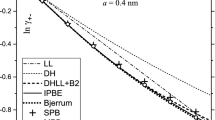Abstract
In this work we present an interaction-site theory for mixture electrolyte solutions. The theory is semi theoretically adjusted for dielectrical properties. The theory preserves the correct asymptotic limits of the dielectric constant when the solution approaches the limit of any of its pure component. In the intermediate concentration range it interpolates the dielectric constants according to a quadratic mixing rule in relative dipole densities. For the simplified interaction-site models applied here, the excess energies of water/methanol at 293.15 K and experimentally measured densities are in fair agreement with experimental values. The estimated average number of hydrogen bonds for a mole fraction of water equal to 0.75 also compares well with published simulations. Estimated energies with and without the dielectric correction indicate that the dielectric constant may have a significant impact on the energy for this molecule. Excess energies for mixtures of water and ethanol are estimated to be too low.
Similar content being viewed by others
References
J. S. Perkyns and B. M. Pettitt,J. Chem. Phys. 97:7656 (1992).
J. S. Haye and G. Stell,J. Chem. Phys. 65:19 (1976).
B. Kvamme,Fluid Phase Equil. 101:157 (1994).
M. J. Gillan,Mol. Phys. 38:1781 (1979).
D. A. Zichi and P. J. Rossky,J. Chem. Phys. 84:1713 (1986).
J. D. Talman,J. Comput. Phys. 29:35 (1978).
P. J. Rossky and H. L. Friedman,J. Chem. Phys. 72:5694 (1980).
J. G. Kirkwood and F. P. Buff.J. Chem. Phys. 19:774 (1951).
P. G. Kusalik and G. N. Patey,J. Chem. Phys. 86:511 (1987).
G. Palinkas, E. Hawlicka. and K. Heinzinger,J. Phys. Chem. 91:4334 (1987).
G. Palinkas and I. Bako,Z. Naturforsch. 46a:95 (1990).
J. S. Haye and G. Stell.J. Chem. Phys. 61:562 (1974).
D. Levesque, J. J. Weis, and G. N. Patey.J. Chem. Phys. 72:1887 (1980).
J. S. Hoye and G. Stell.J. Chem. Phys. 70:2893 (1980).
W. L. Jorgensen,J. Am. Chem. Soc. 103:335 (1981).
J. Chandrasekhar, D. C. Spellmeyer, and W. M. Jorgensen,J. Chem. Phys. 84:5836 (1984).
B. Kvanune and R. T. Holla, Structure and thermodynamics of small polar interactionsite molecules by canonical molecular dynamics and integral equation theory. presented at the 7th Nordic Symposium on Computer Simulation, Espoo. Finland, Sept. 3–5 (1993).
R. C. Weast,Handbook of Chemistry and Physics, 68th ed. (CRC, Boca Raton, FL, 1987).
S. Westeneier,Chem. Techn. Leipzig 28:350 (1976).
G. Palinkas and I. Bako.Z. Naturforsch. 46a:95 (1991).
F. Hirata and P. J. Rossky.Chem. Phys. Lett. 83:339 (1981).
D. Chandler,Mol. Phys. 31:1313 (1976).
Author information
Authors and Affiliations
Rights and permissions
About this article
Cite this article
Kvamme, B. Interaction-site representation of polar mixtures and electrolyte solutions. Int J Thermophys 16, 743–750 (1995). https://doi.org/10.1007/BF01438859
Issue Date:
DOI: https://doi.org/10.1007/BF01438859



